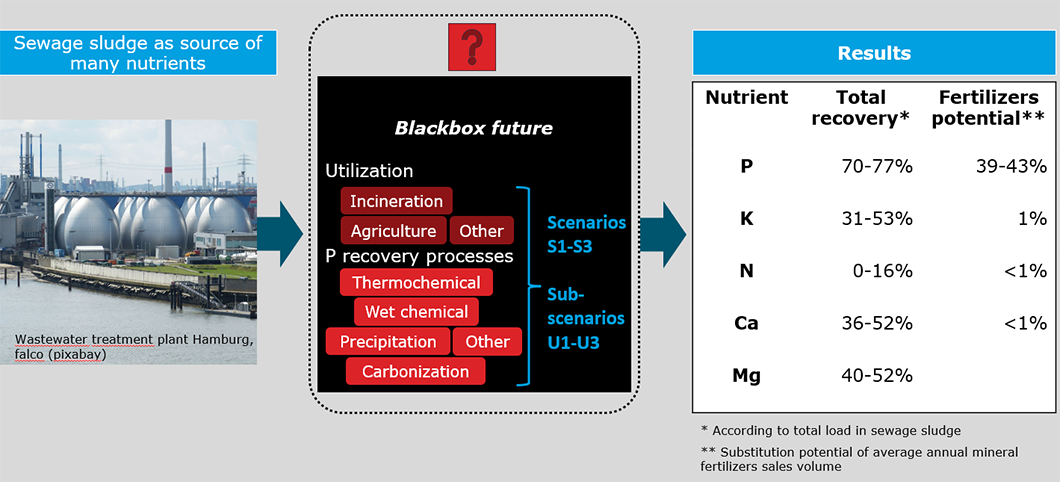
Calculated future expected nutrient recovery from sewage sludge based on three scenarios, each with three sub-scenarios
Source: BAM, Thermochemical Residues Treatment and Resource Recovery
In Germany, municipal wastewater treatment produces around 1,700 billion kg of municipal sewage sludge in dry matter (DM) every year. This sewage sludge contains large amounts of the essential plant nutrient phosphorus. The results of the study show that 70-77% of the total phosphorus load in sewage sludge is likely to be recovered in future. This recovered phosphorus amount could substitute more than 40% of the annual mineral fertilizers sales volume.
Since only a small proportion of sewage sludge in Germany is subject of agricultural utilization today (direct application in agriculture), the German Sewage Sludge Ordinance (rewritten in 2017) prescribes a phosphorus recovery from sewage sludge as of 2029. Phosphorus can be recovered at the wastewater treatment plant (WWTP) from wastewater and sludge water, from sewage sludge, or from sewage sludge ash after incineration. These different processes have different yields (< 20 to > 80% based on the total phosphorus load of the WWTP). Moreover, several processes offer the possibility to recover other nutrients such as nitrogen, magnesium, potassium, and calcium. Based on evaluations of raw data from the federal authorities on nutrient contents in German sewage sludge and various technical processes for phosphorus recovery, three scenarios for future sewage sludge utilization and phosphorus recovery were designed. These scenarios consider different developments including a complete exit of agricultural sewage sludge utilization.
A recovery of 70-77% of the total phosphorus load in sewage sludge represents a significant increase over phosphorus recovery from previous purely agricultural sewage sludge utilization, which has been less than 15% compared to the total load. In addition, the scenarios yield recovery rates of up to maximum 50% for nitrogen, calcium, potassium, and magnesium. However, compared to the average annual mineral fertilizer sales, these amounts represent less than 1% for the above-mentioned nutrients in contrast to phosphorus.
Depending on the recovery process, up to more than 90% of the total amount of phosphorus can be recovered from sewage sludge ash. The obligation to recover phosphorus will thus be able to reverse the trend from material (agricultural sewage sludge utilization) to purely thermal utilization (incineration followed by ash deposition), at least for partial components of sewage sludge, and make an important contribution to circular economy in Germany.
Future nutrient recovery from sewage sludge regarding three different scenarios - German case study
Theresa Constanze Sichler, Christian Adam, D. Montag, M. Barjenbruch
published in Journal of Cleaner Production, Vol. 333, article 130130, pages 1-10, 2022
BAM Thermochemical Residues Treatment and Resource Recovery division


